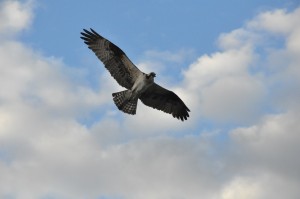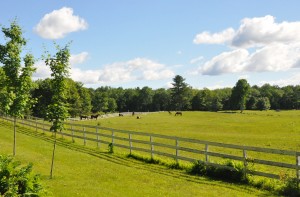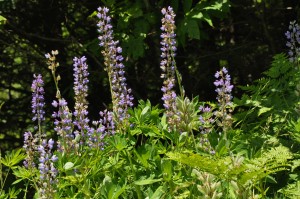It is the light, it is the air, the dark featheriness of pine and fir, and the distinct chill of a summer’s evening. Our camp on Squam Lake in New Hampshire, my realest “home” gave me this with each visit; and now so does Maine.
Whether it was the strangeness of the room, the fatigue that fights with sleep or the glaucous reflections from this estuary of the Kennebec River, I was awake at five. Hopeful of beautiful views, needful of a loosening walk, mindful of the overbooked days ahead, I slipped into yesterday’s clothes, collecting camera, sneakers and room key, and left My Dear One to his rest.
Bath is mostly silent at this hour. Only the trucks rumbling over the Sagadahoc Bridge reminded me of distant places and obligations. I paused high above the water to look at the Iron Works and contemplate the geometries of beams and rivets, and disturbed an osprey on her nest. She flapped aloft, circling above me, her angry whistle like the sound of a steaming tea kettle. I watched and stood my ground as she swooped and dove; her mate arrived and settled on a cable, calling to her, soothing her, or maybe just saying that he would take over defense. I understood their displeasure; their nest on its firm metal platform was high above the water but on level with the pedestrian walkway of the bridge. They had chosen a secure location to raise a brood but a location exposed to gawkers like me.
In Maine even the interstates are scenic, but how much lovelier to take the back roads. Birches stand in elegant contrapposto in forests of oak and maple. Clouds compete with them in whiteness as they loll in the blue overhead. Pastures curve down hillsides like bedclothes rumpled over pillows and ruched up as dreamers turn in restless sleep. Signs promise that moose are likely to lumber into view, but none do. Old farmhouses, modern maisonettes, the occasional trailer are as comfortable in their settings as the boulders and brooks that shaped the landscape.
In Maryland, spring is long gone by the time the solstice arrives. Azalea, crabapple, rhododendron and iris have all had their day, and the splashes of pink and purple and yellow have disappeared into countless shades of green. In Maine, though the rhodies and lilacs are still masses of blossoms, peonies loll in gardens and wildflowers fill the fields. And the lupines, the violet-blue lupines, with occasional stems blooming white. They cluster on the rocky slopes that edge the highways, eschewing the sandy flats of the marshlands for the harsher precincts upland near the trees.
I wanted to capture those lupines, the color that I love above all others, and we drove down roads that offered only buttercups and daylilies until, resigned to failure, we found them again as the long ramp finally merged with I-295. The car safely parked off-road, even off-breakdown-lane, fully on the sandy, weedy shoulder, I picked my way through waving grasses, downhill then up to photograph a modest stand. I also learned that if topography forms a ditch, I can be sure that water runs through it. My brand-spanking-new Brooks trainers squished with every step; my socks turned the rusty umber of the mud dissolved in those invisible runs.





